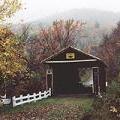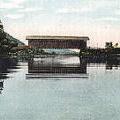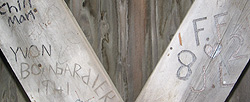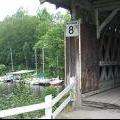 A hundred and twenty years after it was built, and twenty-five years after it was by-passed, the covered bridge over the Fitch Bay Narrows is still standing. Located along Highway 247 between Beebe (Stanstead) and Georgeville, the old bridge, with its newer concrete cousin not far away, sits at the foot of two steep ridges that rise on either side of Fitch Bay, which is a long offshoot (almost a fjord, in fact) of Lake Memphremagog. The bridge spans the bay at its narrowest point -- hence its name "Narrows Bridge."
A hundred and twenty years after it was built, and twenty-five years after it was by-passed, the covered bridge over the Fitch Bay Narrows is still standing. Located along Highway 247 between Beebe (Stanstead) and Georgeville, the old bridge, with its newer concrete cousin not far away, sits at the foot of two steep ridges that rise on either side of Fitch Bay, which is a long offshoot (almost a fjord, in fact) of Lake Memphremagog. The bridge spans the bay at its narrowest point -- hence its name "Narrows Bridge."
In the 1970s, the Narrows Bridge was slated to be torn down. Thanks to a public outcry, it was saved from demolition, and a new bridge was built alongside it. A few years later, the covered bridge underwent renovations, including a new tin roof and a fresh coat of paint. Since then, with occasional minor repairs, it has stood up remarkably well.
 ONE OF THE OLDEST
ONE OF THE OLDEST
One of the oldest surviving covered bridges in the province, and one of only two to cross part of a lake, the Narrows Bridge dates back to 1881, when local builders from Georgeville, Charles and Alexander McPherson, were awarded the building contract for the princely sum of $775. The agreement, dated January 22, 1881, specified that the bridge had to be "completed and ready for public travel" by June of that year.(1)
 "OF FIRST QUALITY"
"OF FIRST QUALITY"
The McPhersons got to work immediately and opted for the tried and true covered bridge structure known as the "Town lattice," named after an American who patented the design in 1820. The contract and specifications stressed the concern of the local building committee that the work be done skillfully and that only quality woods were to be used. Indeed, every detail was clearly set out in the document, from the "four knees of tamarack bolted to the side posts and free from sap and all defects," to the cross rods of "one inch round iron with strong heads and nuts," to the camber of 2 ½ inches.
That the materials were indeed "of first quality" and the "workmanship first class" can hardly be doubted. The covered bridge endured close to a century of continuous and increasingly heavy use. And since its forced semi-retirement in 1977, it has fared admirably.
 FISHERMEN AND SWEETHEARTS
FISHERMEN AND SWEETHEARTS
Today, the Narrows Bridge is a favourite spot for local fishermen angling for bass, and picnickers who, when it rains, take advantage of the shelter the bridge provides. Lovers still carve their sweethearts' names on the inside walls. Some things never change, it seems, for if one looks closely, faded inscriptions dating back a century or more can still be seen.
On the outside of the bridge a peeling sign instructs American boaters to report to the nearest Canadian Customs and to avoid paying the fine for not doing so. The bridge is six or seven miles by boat from the American border, and about the same by car.
 The steep backdrop of forest on the north side of the Narrows makes the Narrows Bridge a truly spectacular subject for photography, especially during the colourful fall season. When all around is a fiery blaze of red and orange, it is a spot that is not to be missed.
The steep backdrop of forest on the north side of the Narrows makes the Narrows Bridge a truly spectacular subject for photography, especially during the colourful fall season. When all around is a fiery blaze of red and orange, it is a spot that is not to be missed.
Reference:
(1) The original contract is in the Archives of the Stanstead Historical Society.